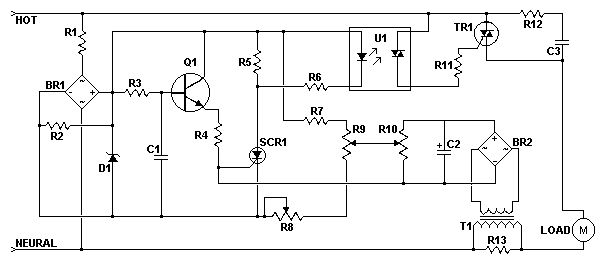This AC motor speed controller can handle most universal type (brushed) AC motors and other loads up to about 250W. It works in much the same was a light dimmer circuit; by chopping part of the AC waveform off to effectively control voltage. Because of this functionality, the circuit will work for a wide variety of loads including incandescent light bulbs, heating elements, brushed AC motors and some transformers. The circuit tries to maintain a constant motor speed regardless of load so it is also ideal for power tools. Note that the circuit can only control brushed AC motors. Inductive motors require a variable frequency control.

Part | Total Qty. | Description | Substitutions |
R1 | 1 | 27K 1W Resistor |
|
R2 | 1 | 10K 1/4W Resistor |
|
R3 | 1 | 100K 1/4W Resistor |
|
R4 | 1 | 33K 1/4W Resistor |
|
R5 | 1 | 2.2K 1/4W Resistor |
|
R6 | 1 | 1K 1/4W Resistor |
|
R7 | 1 | 60K Ohm 1/4W Resistor |
|
R8 | 1 | 3K Linear Taper Trim Pot |
|
R9 | 1 | 5K Linear Taper Pot |
|
R10 | 1 | 4.7K Linear Taper Trim Pot |
|
R11 | 1 | 3.3K 1/4W Resistor |
|
R12 | 1 | 100 Ohm 1/4W Resistor |
|
R13 | 1 | 47 Ohm 1W Resistor (See Notes) |
|
C1, C3 | 2 | 0.1uF Ceramic Disc Capacitor |
|
C2 | 1 | 100uF 50V Electrolytic Capacitor |
|
D1 | 1 | 6V Zener Diode |
|
Q1 | 1 | 2N2222 NPN Transistor | 2N3904 |
SCR1 | 1 | ECG5400 |
|
TR1 | 1 | TRIAC (See Notes) |
|
U1 | 1 | DIAC Opto-Isolator (See Notes) |
|
BR1, BR2 | 2 | 5A 50V Bridge Rectifier |
|
T1 | 1 | Transformer (See Notes) |
|
MISC | 1 | PC Board, Case, Line Cord, Socket For U1, Heatsinks |
|
|
Notes
1. TR1 must be chosen to match the requirements of the load. Most generic TRIACs with ratings to support your load will work fine in this circuit. If you find a TRIAC that works well, feel free to leave a comment.
2. U1 must be chosen to match the ratings of TR1. Most generic DIAC based opto-isolators will work fine. If you have success with a specific part, feel free to leave a comment.
3. T1 is any small transformer with a 1:10 turns ratio. The circuit is designed to run on 120V so a 120V to 12V transformer will work. Alternately, you can wind T1 on a transformer core using a primary of 25 turns, a secondary of 200 turns, and 26 gauge magnet wire.
4. R9 is used to adjust motor speed. R10 is a trim pot used to fine tune the governing action of the circuit. R8 fine tunes the feedback circuit to adjust for proper voltage at the gate of SCR1. It should be adjusted to just past the minimum point at which the circuit begins to operate.
5. R13 must be chosen to match the load. Generally, larger loads will require a smaller value.
6. Since this circuit is not isolated from mains, it must be built in an insulated case.


0 comments:
Post a Comment